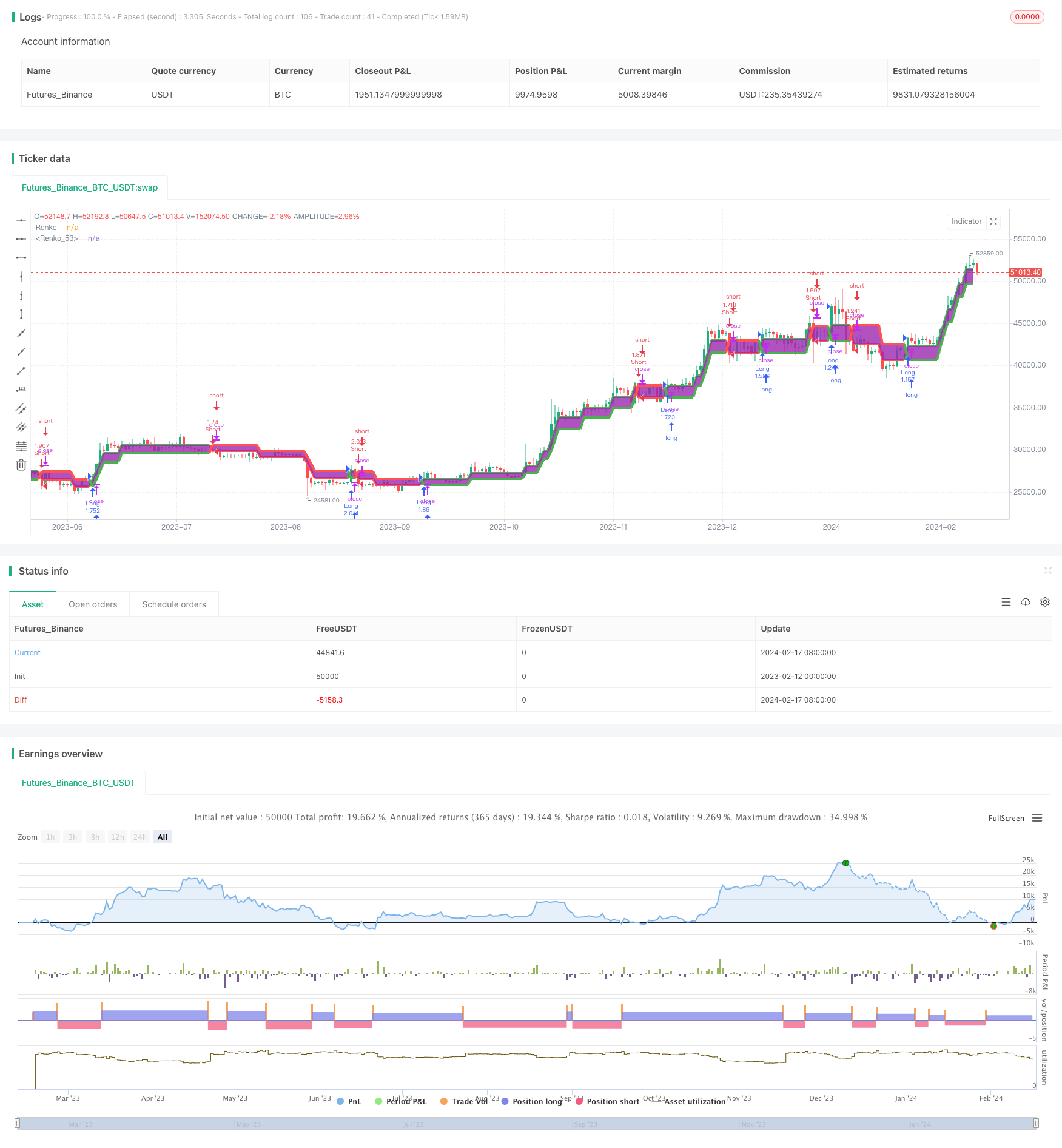
本策略通过模拟砖的形成判断市场动量的变化,根据砖的方向做多做空。
策略原理
该策略的核心原理是通过计算ATR和收盘价的关系来模拟砖的形成。具体来说,定义两个变量Brick1和Brick2。
Brick1的计算方法是:如果收盘价超过Brick1昨日值+ATR的值,则Brick1为Brick1昨日值+ATR;如果收盘价低于Brick1昨日值-ATR的值,则Brick1为Brick1昨日值-ATR;否则Brick1就继承Brick1昨日值。
Brick2的计算方法是:如果Brick1值与Brick1昨日值不等,则Brick2为Brick1昨日值;否则继承Brick2昨日值。
这样就模拟了砖的形成。当Brick1上涨超过一个ATR时,形成一个向上砖;当Brick1下跌超过一个ATR时,形成一个向下砖。Brick2就是记录上一个砖的位置。
当Brick1和Brick2发生向上交叉时,表示砖向上扩展,判断为多头;当Brick1和Brick2发生向下交叉时,表示砖向下收缩,判断为空头。
策略优势
- 利用ATR来判断砖的形成,避免使用固定大小的砖,能动态适应市场波动
- 通过砖的交叉来判断多空方向,识别动量变化
- 可以通过不同的ATR周期来调整对市场动量判断的敏感度
- 可视化的砖形成和交叉情况,直观判断市场走势
策略风险
- ATR大小的选择会影响到策略收益率。如果ATR太小,则形成的砖太多,产生更多无效信号;如果ATR太大,则砖太少,容易错过机会。
- 实际走势可能并不遵循砖的形态,砖的交叉信号可能会被市场反转否决。
- 需要对交易成本非常敏感,否则砖交叉频繁交易会大幅降低净收益。
可以通过参数优化找到最佳的ATR周期;调整止盈止损策略来减少无效信号产生的损失;适当放大交易品种来降低成本对收益的影响。
策略优化
- 可以结合其他指标进行信号过滤,例如量能指标、震荡指标等,避免无效信号
- 增加趋势过滤,只在趋势方向发出信号,避免被反转损失
- 采用测试期内全样本参数优化方法来自动寻找最优参数
总结
本策略通过动态模拟砖的交叉来判断市场中短期趋势和动量,可视化形态直观。策略优化空间较大,参数优化和信号过滤可以进一步提高稳定性。
策略源码
/*backtest
start: 2023-02-12 00:00:00
end: 2024-02-18 00:00:00
period: 1d
basePeriod: 1h
exchanges: [{"eid":"Futures_Binance","currency":"BTC_USDT"}]
*/
//@version=4
///Component Code Start
testStartYear = input(2017, "Backtest Start Year")
testStartMonth = input(01, "Backtest Start Month")
testStartDay = input(1, "Backtest Start Day")
testPeriodStart = timestamp(testStartYear, testStartMonth, testStartDay, 0, 0)
testStopYear = input(2025, "Backtest Stop Year")
testStopMonth = input(1, "Backtest Stop Month")
testStopDay = input(1, "Backtest Stop Day")
testPeriodStop = timestamp(testStopYear, testStopMonth, testStopDay, 0, 0)
/// A switch to control background coloring of the test period
testPeriodBackground = input(title="Color Background?", type=input.bool, defval=false)
testPeriodBackgroundColor = testPeriodBackground and time >= testPeriodStart and time <= testPeriodStop ?
#00FF00 : na
bgcolor(testPeriodBackgroundColor, transp=97)
testPeriod() => true
/// Component Code Stop
//Zack_the_Lego (original AUTHOR) made into strategy by mkonsap
strategy("Flex Renko Emulator", overlay=true, default_qty_type=strategy.percent_of_equity, default_qty_value=100)
margin = input(true, title="Margin?")
Margin = margin ? margin : false
res = input(type=input.resolution, defval="D", title="Resolution of ATR")
xATR = atr(14)
//TF = x78tf ? "78" : "39"
BrickSize = security(syminfo.tickerid, res, xATR)
//Brick1 = close > nz(Brick1[1]) + BrickSize ? nz(Brick1[1]) + BrickSize : close <
//nz(Brick1[1]) - BrickSize ?
//nz(Brick1[1]) - BrickSize
//: nz(Brick1[1]))
Brick1() =>
s1 = 0.0
s1 := close > nz(s1[1]) + BrickSize ? nz(s1[1]) + BrickSize :
close < nz(s1[1]) - BrickSize ? nz(s1[1]) - BrickSize : nz(s1[1])
s1
Brick2() =>
s2 = 0.0
Brick1_1 = Brick1()
s2 := Brick1() != Brick1()[1] ? Brick1_1[1] : nz(s2[1])
s2
colorer = Brick1() > Brick2() ? color.green : color.red
p1 = plot(Brick1(), color=colorer, linewidth=4, title="Renko")
p2 = plot(Brick2(), color=colorer, linewidth=4, title="Renko")
fill(p1, p2, color=color.purple, transp=50)
mylong = crossover(Brick1(), Brick2())
myshort = crossunder(Brick1(), Brick2())
last_long = float(na)
last_short = float(na)
last_long := mylong ? time : nz(last_long[1])
last_short := myshort ? time : nz(last_short[1])
in_long = last_long > last_short ? 2 : 0
in_short = last_short > last_long ? 2 : 0
mylong2 = crossover(Brick1(), Brick2())
myshort2 = crossunder(Brick1(), Brick2())
last_long2 = float(na)
last_short2 = float(na)
last_long2 := mylong2 ? time : nz(last_long2[1])
last_short2 := myshort2 ? time : nz(last_short2[1])
in_long2 = last_long2 > last_short2 ? 0 : 0
in_short2 = last_short2 > last_long2 ? 0 : 0
condlongx = in_long + in_long2
condlong = crossover(condlongx, 1.9)
condlongclose = crossunder(condlongx, 1.9)
condshortx = in_short + in_short2
condshort = crossover(condshortx, 1.9)
condshortclose = crossunder(condshortx, 1.9)
// === STRATEGY - LONG POSITION EXECUTION WITH CLOSE ORDERS ===
//enterLong() => crossover(condlongx, 1.9) and testPeriod() and strategy.position_size <= 0
//exitLong() => crossunder(condlongx, 1.9) and testPeriod() and strategy.position_size > 0
//strategy.entry(id = "Long", long = true, when = enterLong())
//strategy.close(id = "Long", when = exitLong())
// === STRATEGY - SHORT POSITION EXECUTION WITH CLOSE ORDER===
//enterShort() => crossover(condshortx, 1.9) and testPeriod() and strategy.position_size >= 0 and Margin
//exitShort() => crossunder(condshortx, 1.9) and testPeriod() and strategy.position_size < 0
//strategy.entry(id = "Short", long = false, when = enterShort())
//strategy.close(id = "Short", when = exitShort())
//END
///STRATEGY ONLY LONG AND SHORT/////
if crossover(condlongx, 1.9) and testPeriod() and strategy.position_size <= 0
strategy.entry("Long", strategy.long, comment="Long")
if crossover(condshortx, 1.9) and testPeriod() and strategy.position_size >= 0
strategy.close("Long", when=not Margin)
if crossover(condshortx, 1.9) and testPeriod() and strategy.position_size >= 0
strategy.entry("Short", strategy.short, comment="Short", when=Margin)
/////// END ////